The Curved Television Market is estimated to be valued at USD 1.6 billion in 2025 and is projected to reach USD 2.9 billion by 2035, registering a compound annual growth rate (CAGR) of 6.1% over the forecast period. This growth is supported by a steady CAGR of 6.1%, driven by increasing demand for high-quality, immersive viewing experiences and advancements in display technology. In the first five-year phase (2025–2030), the market is expected to reach USD 2.0 billion, adding USD 0.4 billion, which accounts for 30.8% of the total incremental growth, driven by consumer adoption of curved displays in high-end televisions.
The second phase (2030–2035) contributes USD 0.9 billion, representing 69.2% of incremental growth, as improvements in manufacturing processes, broader availability of curved displays in mid-range models, and rising demand from home entertainment systems further drive adoption. Annual increments will increase from USD 0.07 billion in the early years to USD 0.2 billion by 2035, as the market matures and more consumers adopt curved televisions for their unique aesthetic and enhanced viewing angles. Manufacturers focusing on affordability, screen size options, and integration with smart TV features will capture significant value in this USD 1.3 billion opportunity.
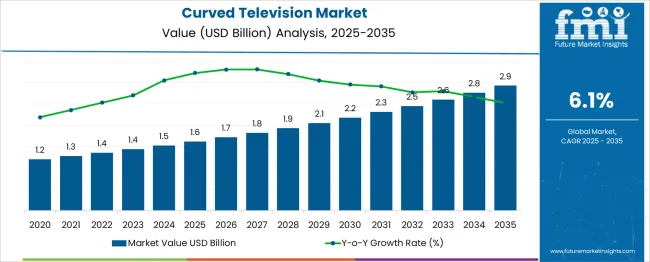
| Metric | Value |
|---|---|
| Curved Television Market Estimated Value in (2025 E) | USD 1.6 billion |
| Curved Television Market Forecast Value in (2035 F) | USD 2.9 billion |
| Forecast CAGR (2025 to 2035) | 6.1% |
The curved television market is undergoing robust expansion driven by the growing appetite for premium home viewing experiences, particularly in urban and semi-urban households. Enhanced visual immersion offered by curved panels, coupled with the integration of advanced audio and display technologies, is drawing strong consumer interest. Manufacturers have been investing in display curvature optimization to reduce distortion and increase field-of-view, supporting adoption in both home entertainment and commercial display segments.
The rising availability of high-resolution content, particularly in 4K and HDR formats, has further encouraged consumers to upgrade to visually superior television models. Market players are also focusing on aesthetic appeal and wall-mount compatibility, making curved displays suitable for modern interior environments.
Technological developments in OLED and Quantum Dot displays have increased color accuracy and brightness uniformity, enhancing the value proposition of curved televisions. As smart TV ecosystems grow with AI voice control and IoT integration, the curved television market is positioned to benefit from continued innovation and rising demand for immersive, large-screen formats.
The curved television market is segmented by screen size, resolution, display technology, end user, distribution channel, and geographic regions. The curved television market is divided by screen size into 50″–64″, 32″–49″, 65″, and above. In terms of resolution, the curved television market is classified into 4K UHD, Full HD (1080p), 8K UHD, and other resolutions. The curved television market is segmented into OLED, LED-LCD, QLED, MicroLED, and others. The end user of the curved television market is segmented into Residential, Commercial (e.g., hotels, corporate spaces), and Public viewing (stadiums, control rooms). The distribution channel of the curved television market is segmented into Online retail, Electronics specialty stores, Hypermarkets & supermarkets, Direct sales, and others. Regionally, the curved television industry is classified into North America, Latin America, Western Europe, Eastern Europe, Balkan & Baltic Countries, Russia & Belarus, Central Asia, East Asia, South Asia & Pacific, and the Middle East & Africa.
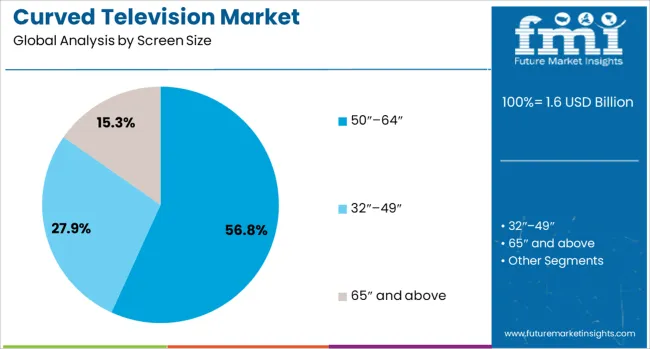
The 50″–64″ screen size segment is expected to account for 56.8% of the total revenue share in the curved television market in 2025, making it the dominant category by size. Growth in this segment has been influenced by the increasing consumer inclination toward moderately large screens that offer cinematic visual experiences while remaining practical for average-sized living spaces. These screen dimensions strike a balance between immersion and affordability, making them ideal for a wide range of households.
Manufacturers have been tailoring product lines in this range to include enhanced display features such as high refresh rates, deep contrast ratios, and slim bezels, all of which appeal to performance-conscious buyers. Additionally, this size category benefits from optimized manufacturing yields and competitive pricing structures, making it more accessible across price-sensitive regions.
Retail promotions and the increasing penetration of e-commerce platforms have further boosted volume sales in this segment. As content streaming continues to surge, this screen size range is anticipated to remain central to consumer preferences in both emerging and mature markets.
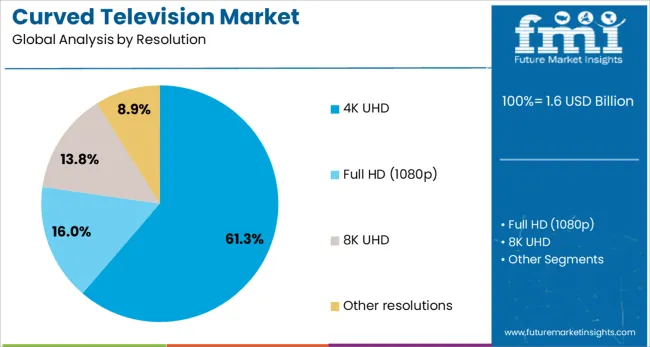
The 4K UHD resolution segment is projected to hold 61.3% of the curved television market revenue share in 2025, reflecting its status as the leading resolution choice among consumers. This segment’s growth is supported by the increasing availability of native 4K content across streaming platforms, gaming consoles, and satellite broadcasts. Enhanced pixel density and sharper image rendering offered by 4K displays have significantly improved visual clarity and realism, aligning with the immersive goals of curved panel design.
Consumer expectations for high-definition content have risen in parallel with advancements in graphics and cinematography, making 4K a baseline requirement in premium television segments. Manufacturers have also standardized 4K resolution across most mid and high-tier models, making it widely available across pricing brackets.
Additionally, improvements in upscaling algorithms have allowed even non-native content to appear sharper on 4K panels. With growing broadband access and content partnerships, the 4K UHD segment is expected to maintain its leadership as the resolution of choice for curved television consumers globally.
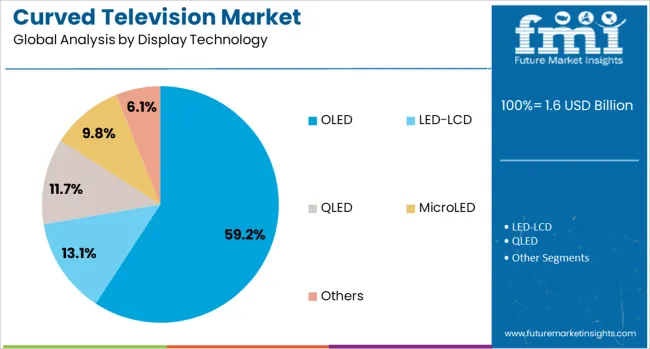
The OLED display technology segment is forecast to contribute 59.2% of the curved television market’s total revenue share in 2025, reinforcing its role as the dominant panel technology. The rise of this segment has been attributed to the superior contrast ratios, vibrant color reproduction, and ultra-slim form factors made possible by OLED panels. Unlike conventional backlit technologies, OLED allows each pixel to emit its own light, resulting in perfect blacks and higher dynamic range, features that significantly enhance the depth perception on curved screens.
These attributes have made OLED panels particularly effective in delivering a true-to-life viewing experience, closely aligning with the immersive intent of curved TV design. The growing availability of large-sized OLED panels and improvements in manufacturing scalability have lowered costs and increased accessibility.
Furthermore, OLED’s flexibility in panel curvature design has supported sleek product innovations, especially in premium and designer-oriented models. As environmental concerns and energy efficiency gain importance, the power-saving benefits of OLED are also expected to contribute to the segment’s sustained dominance.
The curved television market is growing, driven by rising demand for immersive viewing experiences and enhanced visual quality in home entertainment. Growth drivers in 2024 and 2025 include the increasing consumer preference for high-definition televisions and the expansion of smart TV functionalities. Opportunities are emerging in the luxury and high-end home entertainment sectors. Emerging trends include integration with advanced streaming services. However, market restraints include the high cost of curved TVs and competition from flat-panel displays, limiting mass adoption.
The major growth driver in the curved television market is the increasing demand for immersive viewing experiences. In 2024, consumers sought televisions that offered better picture quality and more engaging viewing experiences. Curved TVs, with their design that enhances depth and realism, became popular in home entertainment systems. As demand for larger, high-definition displays continues to rise, curved televisions are being adopted by those looking for a more cinematic feel in their living rooms.
Opportunities in the curved television market are emerging in the luxury home entertainment segment. In 2025, manufacturers focused on producing high-end, larger-sized curved TVs with advanced features like 4K and 8K resolution, catering to the growing demand from affluent consumers. Luxury home theater systems that incorporate curved displays are increasingly seen as status symbols. As disposable income rises, particularly in developing countries, the demand for premium televisions is expected to boost growth in this niche market.
Emerging trends in the curved television market include the integration of advanced streaming services and smart TV features. In 2024, curved TVs began to incorporate technologies such as voice assistants, smart home integration, and access to popular streaming platforms like Netflix and Disney+. This trend is reshaping the consumer television experience, enabling seamless access to on-demand content and enhanced connectivity. As smart TVs become more central to home entertainment ecosystems, the adoption of curved models is expected to increase.
The major market restraints include the high cost of curved televisions and competition from flat-panel displays. In 2024 and 2025, curved TVs remained expensive, particularly for larger models with premium features, which limited their appeal to budget-conscious consumers. Additionally, flat-panel displays, with their lower price point and comparable viewing quality, continue to dominate the market. These factors pose challenges for curved TVs to gain significant market share, particularly in price-sensitive regions.
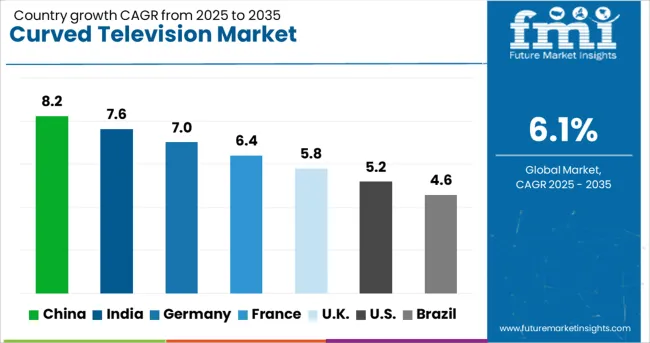
| Country | CAGR |
|---|---|
| China | 8.2% |
| India | 7.6% |
| Germany | 7.0% |
| France | 6.4% |
| UK | 5.8% |
| USA | 5.2% |
| Brazil | 4.6% |
The global curved television market is expected to grow at a 6.1% CAGR from 2025 to 2035. China leads with an 8.2% CAGR, followed by India at 7.6%, and Germany at 7.0%. The United Kingdom records a growth rate of 5.8%, while the United States shows the slowest growth at 5.2%. The varying growth rates are driven by regional technological advancements, consumer preferences, and infrastructure. China and India, with their rapidly expanding consumer electronics markets, are experiencing higher adoption rates, while more mature markets like the USA and the UK see slower growth due to the saturation of existing product offerings. This report provides a comprehensive analysis of the key countries driving the Curved Television market's growth.
The curved television market in China is experiencing rapid growth, with a projected CAGR of 8.2%. The country’s strong manufacturing base and increasing disposable income are driving consumer demand for high-quality, immersive television experiences. China’s growing interest in smart home technologies and the demand for innovative entertainment solutions are key factors propelling the adoption of curved televisions. As consumer preferences shift toward enhanced viewing experiences, fueled by advances in display technologies, China continues to dominate the curved television market. Furthermore, the rise in e-commerce platforms also facilitates greater product accessibility and adoption.
The curved television market in India is projected to grow at a strong CAGR of 7.6%. The demand for premium entertainment solutions is increasing, particularly in urban areas, as consumers seek better viewing experiences. India’s rapidly growing middle class, coupled with rising disposable incomes, is contributing to the growth of curved television adoption. The country's expanding digital infrastructure and increasing penetration of streaming services further support market growth. As the preference for advanced, feature-rich televisions increases, India is becoming one of the key markets for curved television manufacturers looking to expand their presence in the region.
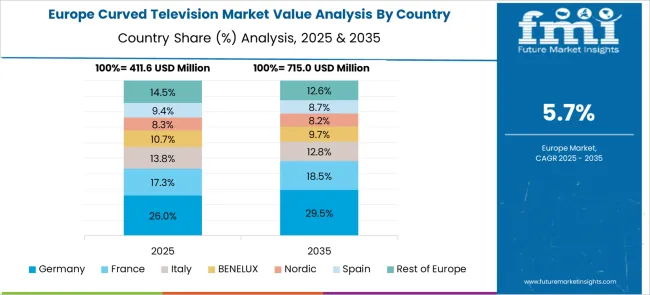
The curved television market in Germnay is expected to grow at a CAGR of 7.0%. As one of the leading consumer electronics markets in Europe, Germany sees strong demand for high-quality home entertainment solutions. The increasing trend toward premium television products, combined with rising consumer interest in immersive viewing experiences, is driving the market. Germany’s well-established retail and e-commerce channels also facilitate easy access to curved televisions. Moreover, advancements in display technology, such as OLED and 4K resolution, further enhance the appeal of curved televisions among German consumers.
The curved television market in the United Kingdom is projected to grow at a moderate CAGR of 5.8%. While the market is relatively mature, demand remains steady due to the increasing preference for larger screens and enhanced viewing experiences. The UK’s focus on upgrading home entertainment systems, coupled with a growing interest in smart home technologies, continues to support the adoption of curved televisions. However, the market faces challenges due to the saturation of existing consumer electronics products and the rising popularity of flat-screen alternatives. Despite these challenges, the market for curved televisions remains robust.
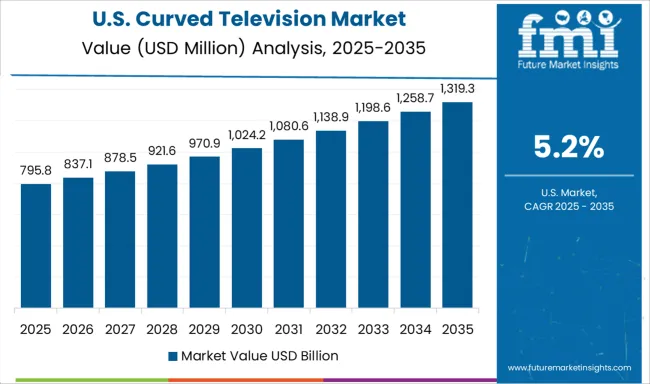
The curved television market in the United States is expected to grow at a CAGR of 5.2%. The USA market remains strong, driven by consumer interest in advanced display technologies, such as 4K resolution and OLED. The growing adoption of smart home technologies and the increasing popularity of immersive entertainment experiences are key growth drivers. However, the market faces challenges due to the saturation of the television market, where flat-screen alternatives continue to dominate. Despite these obstacles, the USA remains one of the leading markets for curved televisions, particularly among consumers seeking premium entertainment solutions.
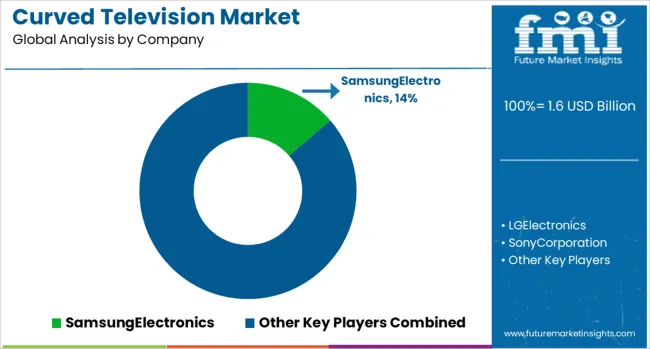
Leading electronics giants such as Samsung, LG, Sony, TCL, and Hisense have focused on product innovation as a primary lever, investing in advanced display technologies like OLED, QLED, and 8K resolution to enhance immersion and deliver a superior viewing experience. A notable strategy has been the incorporation of artificial intelligence and smart integration, with voice assistants, adaptive brightness, and personalized recommendations, positioning curved televisions as more than display devices but rather as central entertainment hubs. Branding and design aesthetics also remain critical, as firms promote curved televisions as luxury lifestyle products, often tying their campaigns to cinematic experiences, sports broadcasting, and gaming ecosystems. Companies like Samsung and LG have additionally adopted dual-pronged pricing strategies, offering premium flagship curved models for high-income consumers while simultaneously introducing slightly lower-priced alternatives to appeal to aspirational buyers in emerging markets. Distribution strategies have further diversified, with global players strengthening their e-commerce presence and direct-to-consumer channels, while regional manufacturers seek partnerships with local retailers to penetrate underserved geographies. Another defining approach has been market positioning through gaming-focused features, with enhanced refresh rates, HDR support, and ultra-wide curvature marketed as immersive tools for console and PC gamers. At the same time, manufacturers have been refining supply chains and pursuing modular production techniques to optimize costs in a relatively specialized product line.
| Item | Value |
|---|---|
| Quantitative Units | USD 1.6 Billion |
| Screen Size | 50″–64″, 32″–49″, and 65″ and above |
| Resolution | 4K UHD, Full HD (1080p), 8K UHD, and Other resolutions |
| Display Technology | OLED, LED-LCD, QLED, MicroLED, and Others |
| End User | Residential, Commercial (e.g. hotels, corporate spaces), and Public viewing (stadiums, control rooms) |
| Distribution Channel | Online retail, Electronics specialty stores, Hypermarkets & supermarkets, Direct sales, and Others |
| Regions Covered | North America, Europe, Asia-Pacific, Latin America, Middle East & Africa |
| Country Covered | United States, Canada, Germany, France, United Kingdom, China, Japan, India, Brazil, South Africa |
| Key Companies Profiled | SamsungElectronics, LGElectronics, SonyCorporation, PanasonicCorporation, TCLTechnology, HisenseGroup, SkyworthGroup, HaierGroup, KonkaGroup, SharpCorporation, Philips(TPVTechnology), VizioInc., XiaomiCorporation, ChanghongElectric, and VestelGroup |
| Additional Attributes | Dollar sales by television type and application, demand dynamics across consumer electronics and entertainment sectors, regional trends in curved TV adoption, innovation in display technologies and ultra-high-definition formats, impact of regulatory standards on energy efficiency, and emerging use cases in smart homes and immersive viewing experiences. |
The global curved television market is estimated to be valued at USD 1.6 billion in 2025.
The market size for the curved television market is projected to reach USD 2.9 billion by 2035.
The curved television market is expected to grow at a 6.1% CAGR between 2025 and 2035.
The key product types in curved television market are 50″–64″, 32″–49″ and 65″ and above.
In terms of resolution, 4k uhd segment to command 61.3% share in the curved television market in 2025.






Our Research Products

The "Full Research Suite" delivers actionable market intel, deep dives on markets or technologies, so clients act faster, cut risk, and unlock growth.

The Leaderboard benchmarks and ranks top vendors, classifying them as Established Leaders, Leading Challengers, or Disruptors & Challengers.

Locates where complements amplify value and substitutes erode it, forecasting net impact by horizon

We deliver granular, decision-grade intel: market sizing, 5-year forecasts, pricing, adoption, usage, revenue, and operational KPIs—plus competitor tracking, regulation, and value chains—across 60 countries broadly.

Spot the shifts before they hit your P&L. We track inflection points, adoption curves, pricing moves, and ecosystem plays to show where demand is heading, why it is changing, and what to do next across high-growth markets and disruptive tech

Real-time reads of user behavior. We track shifting priorities, perceptions of today’s and next-gen services, and provider experience, then pace how fast tech moves from trial to adoption, blending buyer, consumer, and channel inputs with social signals (#WhySwitch, #UX).

Partner with our analyst team to build a custom report designed around your business priorities. From analysing market trends to assessing competitors or crafting bespoke datasets, we tailor insights to your needs.
Supplier Intelligence
Discovery & Profiling
Capacity & Footprint
Performance & Risk
Compliance & Governance
Commercial Readiness
Who Supplies Whom
Scorecards & Shortlists
Playbooks & Docs
Category Intelligence
Definition & Scope
Demand & Use Cases
Cost Drivers
Market Structure
Supply Chain Map
Trade & Policy
Operating Norms
Deliverables
Buyer Intelligence
Account Basics
Spend & Scope
Procurement Model
Vendor Requirements
Terms & Policies
Entry Strategy
Pain Points & Triggers
Outputs
Pricing Analysis
Benchmarks
Trends
Should-Cost
Indexation
Landed Cost
Commercial Terms
Deliverables
Brand Analysis
Positioning & Value Prop
Share & Presence
Customer Evidence
Go-to-Market
Digital & Reputation
Compliance & Trust
KPIs & Gaps
Outputs
Full Research Suite comprises of:
Market outlook & trends analysis
Interviews & case studies
Strategic recommendations
Vendor profiles & capabilities analysis
5-year forecasts
8 regions and 60+ country-level data splits
Market segment data splits
12 months of continuous data updates
DELIVERED AS:
PDF EXCEL ONLINE
Television Broadcasting Services Market Insights – Growth & Forecast 2023-2033
Television Services Market
Internet Protocol Television Market Size and Share Forecast Outlook 2025 to 2035
Internet Protocol Television (IPTV) CDN Market Size and Share Forecast Outlook 2025 to 2035

Thank you!
You will receive an email from our Business Development Manager. Please be sure to check your SPAM/JUNK folder too.
Chat With
MaRIA